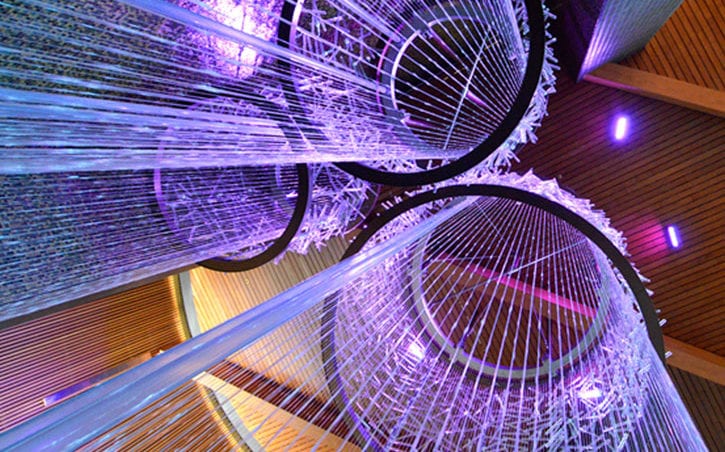Illuminating H2O: Electrical Design Coordination
Posted in Insights -

3 Questions with Chris Roy, Director of Creative Design, OTL, Inc.
Most of us understand intrinsically that water and electricity can make a dangerous pair; pooled water near an electrical socket or a lightning bolt near a body of water can have a life-threatening impact.
That being said, water and electricity can also make a beautiful pair. In fact, so-called “electric light fountains” have been around since 1884, and fountains with electric pumps have been in use since shortly thereafter.
“
The proximity of water and electricity has led to unfortunate fatal incidents over the past 130+ years; fortunately, engineers and investigators have worked together to intervene, writing and re-writing electrical codes to ensure that modern water features are safe and do not present electrical shock hazards to the public.
” Chris Roy, Director of Creative Design for OTL.
While the National Electric Code covers electricity in/around pools and fountains in great detail in Section 680, my latest blog post on Electrical Design Coordination for Water Features addresses the most basic concepts architects, landscape architects, and project owners should keep in mind. For a sneak peek – keep reading below:
1. How close can water and electricity safely be?
The most basic coordination issue is location; a water feature may not be located beneath an existing service drop/power line that isn’t at least 22.5’ above maximum water level, nor can a water feature be located beneath an existing communication cable that isn’t at least 10’ above maximum water level.
Further, underground wiring (except for wiring specifically related to the fountain) is not permitted to run beneath the fountain, nor within a perimeter extending five feet around the fountain.
Electrical outlets cannot be closer than five feet to the to the inside wall of the fountain basin, and any outlets closer than 20’ to the fountain must be protected by a ground-fault circuit interrupter (GFCI). For more details on these regulations, click here to read more.
2. How do the regulations change for outdoor versus indoor fountains?
For outdoor water features, any overhead lighting must be installed at least 12 feet above maximum water level. This is the case for lighting directly above the fountain, as well as above a perimeter extending outward five feet beyond the edge of the water.
Indoor water features must adhere to this same 12-foot clearance, however fully enclosed light fixtures and ceiling fans – such as those used on porches and patios – are allowed to be installed as low as 7.5-feet above maximum water level, provided the branch circuit supplying the equipment is protected by a GFCI.
A deeper dive into these distinctions can be viewed here.
3. What role does bonding play in the safety of electrical engineering for water features?
Nearly all metallic items in a water feature must be bonded.
Bonding safely connects the conductive elements of the fountain structure, metallic fountain components, nearby metallic objects, and electrical equipment enclosures.
This essential function is crucial for fountain safety. By tying all metal components together, each component now has the same potential (equipotential). If one item were to carry voltage, they would all then carry the same voltage.
Because of bonding, if a person touches a metal item and any other conductor (such as the water in a fountain), there is no electricity trying to flow between those two points, and thus no electrical shock.
Grounding is closely related to bonding; in fact, the equipotential bonding described above is part of the fountain’s electrical grounding system.
For a deep dive look at bonding and grounding, click here to read more.

Chris Roy is the Director of Creative Design for Outside the Lines, Inc. In this role, he leads the company’s design efforts, working with developers, architects, and landscape architects, as well as engineers and vendors. Contact him at ChrisR@otl-inc.com.
Featured Articles
- Getting to Know OTL’s Administrative/Accounting Assistant Nathan Touche
- Centers With Well-Designed Experiential Water Features Can Attract 30,000 Visitors Per Week
- Fountains of Light: California Water Features Developer Opens North Texas Office
- AI and Facility Management: How to Avoid Potential Pitfalls
- Safety First and Last: Creating a Safe Site in any Environment